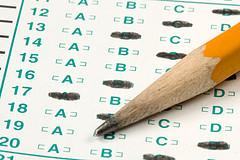My sister asked me why teachers objected to charter schools. Why shouldn’t the money just follow the kids to whatever school the parents choose?
I said that back in the 1970s, when I first started teaching, my first couple of jobs were in little Christian schools. We got paid about a third of what public school teachers made. Almost no benefits. I remember being handed a ream of paper before school started—that was my supply of copy paper for my class for the year. We had no specialists and no support staff.
At that time the parents sometimes talked about how frustrating it was that they paid taxes for public schools and then paid tuition for private school. Why couldn’t they have their own tax money to pay for their tuition?
My sister said, “Exactly.”
I told her the voucher movement started with already existing private schools. Even with that small beginning, the public schools were highly suspicious. I remember a great story from New York City where the public school union reps confronted the Catholic school nuns, accusing them of wanting to take only the best and the brightest of the students and turning away the trouble makers. The nuns said, “You pick who you send to our schools. We’ll take whoever you send.” That shut up the union, as far as those schools were concerned.
The ironic thing was, most of the private religious schools that I knew about quickly turned away from the voucher movement. They decided that money from the government in any form—even in the form of vouchers—would come with government strings attached. And they wanted to preserve their autonomy.
However, the voucher movement continued. Individuals, institutions, organizations—people created charter schools specifically to take advantage of voucher programs. And some charter schools are businesses, designed to make a profit.
I told my sister, I have a hard time reconciling the idea of taking money from public schools to give to private schools that are for-profit institutions.
She said, “Well, that’s ridiculous. That would be wrong.”
On the other hand, I’d like my coworkers who damn all charters with the same brush to take a look at Breakthrough Schools in Cleveland. Breakthrough Schools are a network of charter schools in Cleveland.
- They are NONPROFIT.
- They target some of the city’s neediest areas.
- And they are remarkably successful.
“Nearly all Breakthrough students are students of color, and eight of 10 are low-income.”
“Its schools are in the top third of all schools in the city for academic performance.”

And by the way, Breakthrough Charter Schools joined 20 other high scoring charter schools in opposing President Trump’s education budget, even though the new budget proposes $168 million more for charter schools. They united to oppose the cuts to traditional public schools, saying,
“We need federal support for all schools, for all kids, not just kids in ‘choice’ schools.”
“Budgets are statements of priorities, and this one sends a clear message that public education is not a top priority.”
The group specifically objected to cuts in Pell grants, teacher training, and afterschool programs.
And they reiterated the value of public education as an “essential pillar of our democracy.”
Personally, I can’t reduce the charter school debate to a sound bite. I think for-profit schools should operate with no public money at all. But as far as I am concerned, if Cleveland or Ohio wants to give vouchers to families with children attending Breakthrough Schools, I’d be fine with that. Breakthrough Schools are bringing new people, new energy, and new ideas to a place that desperately needs them—not to make money, but to make a difference.
 endent of Public Instruction, Chris Reykdal outlined a series of phases that addressed his
endent of Public Instruction, Chris Reykdal outlined a series of phases that addressed his  There’s a place on the Washington coast called Taholah. I’ve been there a few times on my bicycle, riding up Highway 109 from Ocean Shores. The scenery is staggering. There’s huge trees everywhere, a river on the north end of town and an ocean to the west.
There’s a place on the Washington coast called Taholah. I’ve been there a few times on my bicycle, riding up Highway 109 from Ocean Shores. The scenery is staggering. There’s huge trees everywhere, a river on the north end of town and an ocean to the west.




 , facing the class and modeling the correct movements in reverse, monitored and corrected each student’s letter formation. Children across the country all learned the same method of writing, they all had handwriting that was similar—and their handwriting was legible.
, facing the class and modeling the correct movements in reverse, monitored and corrected each student’s letter formation. Children across the country all learned the same method of writing, they all had handwriting that was similar—and their handwriting was legible.